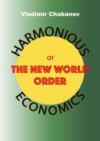Читать книгу: «Harmonious Economics or The New World Order», страница 6
1.2.3. Human needs, commodities and production means
I have fed you with milk, and not with meat: for hitherto ye were not able to bear it, neither yet now are ye able.
Corinthians 3:2
The definition of the main purpose of economic activities provided above is, in fact, incomplete, for it does not specify what human needs are, nor gives a list of them, nor explains the conditions of their existence and satisfaction.
Needs shall be understood from here on as an inner state of psychological or functional feeling of insufficiency of certain factors becoming evident depending on the situation. These are typical both of individuals, and communities, social groups or even the society in general. Needs act as inner incentives for human activity.
Indeed, needs are the main driving force for a human being. Depending on their nature, needs can be divided into vital, spiritual and, social needs. The first category is related to the body’s need for food, dress, dwelling place, motion, rest, health, etc.
The spiritual human needs include the aspiration for personal freedom, for knowledge, for satisfaction of intellectual requirements, aesthetic tastes and harmony, for beauty, culture, morality, and for kindness and empathy. Among spiritual needs we find love and hatred, passion, and level of satisfaction. An important role in every man’s life is played by procreation, communication with other people, friendship and competitiveness. Moreover, factors of psychological comfort are classified among spiritual needs of human beings: self-confidence, prestige, self-realisation, self-respect, authority, etc.
Among social human needs there are security, equality, personal safety and the safety of one’s children, and confidence regarding one’s future. We all want to live surrounded by healthy, happy, kind-hearted, beautiful, and confident people. Besides, we demand from others a high level of mass culture and morality. There also exist specific social needs, such as need for labour, for mental and physical activity, for creativity and creation of new values.
These series are, undoubtedly, conditional and do not cover the entire range of human needs, nor delineate exact borders between different needs.
The needs depend on individual features of people, their living conditions, their gender and age, culture and education, their health, experience, traditions, religion, and national preferences. Besides, the needs are not immutable. With time, they develop, change, and evolve. They are influenced by the social environment of a person, by weather and nature, by the season and the place of residence, by the level of production development, and by the level of personal satisfaction. Moreover, the more one has, the more one needs.
Every individual, as a member of the human species, has certain needs similar to those of other people, human communities, or the society in general. For instance, all reasonable people wish to live in a clean and orderly place, in a country with a low crime rate, with a fair and experienced government, with a strong state structure, with a sound legislation and public order. At the same time, it would be hard to find two people with identical needs.
In fact, the individual perception of each need by different people varies; what some consider the sense of life, other discard as insignificant. Take music away from a melomaniac, there is nothing you could substitute it with. “The stifling of the individual may well be the stifling of the god in man’ (Sri Aurobindo, [16]). This is why there should be respectful attitude to the entire range of human needs. It is evident that satisfying just the needs of an average person, as conceived by planned economy and practiced by the current market economy, would not make anybody happy enough.
On the other hand, human needs cannot be studied just as a random set of factors. In fact, they constitute a harmonious complex that reflects the person. Besides, some needs only exist together with other. For instance, the desire for luxury cannot emerge unless the hunger is satisfied. A trendy hat demands a fashionable dress to be worn with. Nevertheless, the level of correlation and interchangeability of various needs is different and does not impact their importance. The failure to satisfy some needs for a long time might disrupt the inner harmony of a person, and even disfigure them.
However, not all needs may be easily welcomed. For example, thirst for power and selfish ambitions of certain individuals often mean loss of freedom and poverty of others. From the social point of view, only the needs that can be satisfied without violating moral and ethical norms, trampling the rights of other people, of the society, or descendants, are worthy of respect. And it is such needs that we are going to address in this monograph. Other needs should be managed with the help of educational or psychiatric institutions, or law enforcement agencies. Furthermore, the impossibility of their satisfaction should be enshrined in the basic principles of economics and state organisation.
It should be mentioned that when the interests of an individual, a community, and the society match each other and combine harmoniously, this condition is observed without failure. And the fuller the implementation of this principle, the higher the level of society civilisation, and the more grounds to class it as a human society.
On the other hand, human needs are not abstract, they are made evident through certain conditions, things, and services that a human being requires. Therefore, everything that satisfies human needs, everything required for a decent living, that supports and restores human health, increases life tonus, encourages and assures procreation, etc. is classified in the group of commodities. Among these we find food and water; clothes and housing; medical assistance and sport facilities; spiritual wealth and clean nature. Besides, this group includes the goods and services that are provided to people by service sector actors, as well as by spheres that satisfy social needs (such as governance, science, education, healthcare, and defence).
Human labour is also classified among commodities, because, on the one hand, it satisfies human needs related to self-realisation; on the other hand, it is the driving force of production. Though, in fact, all other commodities can be described in this way, too. That is why the more they satisfy human needs, the more productive human labour is. Many things can be obtained by humans directly from nature without additional effort, the rest are produced by the people themselves. In the remaining part of this monograph this latter category will mostly be considered.
As a rule, needs exceed the total amount of commodities available, which stimulates people to act and develop, becoming an instrument capable of managing them. There exists an optimal correlation between the needs and the number of commodities to satisfy them. If the correlation exceeds the optimal value, that is, almost all needs are satisfied, this decreases the desire to work, and slows down development. However, if this correlation is below the optimal, then the needs become extinct, and the individuals live through degradation. Countries with huge property inequalities witness both these tendencies, which can lead to catastrophic results.
At the same time, if within a state there exists a tendency to satisfy one’s needs not through labour and productive talent, that is, by way of contributing to the productive efforts of the society, but through appropriation of goods generated by others, this inevitably entails destruction of both the production and the moral systems. Whether it comes from the top or from the bottom, such destruction contributes to the degradation of the state and the society. This has already been the case numerous times and history; similar situation can be witnessed across the world today.
For practical economics the classification of commodities into individual, collective and public is essential, for they are consumed in different manners. Individual commodities include the items that a person and their family members use outside of interaction with other people: housing, clothes, food, household items, cultural items, etc. Collective commodities category embraces the things that a person uses jointly with other people at the place of residence, work, or rest. These are medical services and police; utilities services and public transport; cultural, religious and sport facilities; roads, means of communication and many other things. Finally, public commodities are government entities and the army; higher educational institutions and communications; defensive structure and security systems; scientific, cultural and educational institutions. To sum up – all the services that satisfy the needs of all people belonging to a state and a society.
This classification explains why the distribution has a more significant impact on production, and expenses – on earnings. In fact, all commodities possess a certain duality of nature. On the one hand, they satisfy human needs; on the other – encourage production. Collective and public commodities are consumed by humans differently from individual ones, and the dependence of people on such commodities is quite different. Therefore, for each group of commodities specific distribution forms may be worked out to stimulate as much as possible their production and eventually improve the life quality and the morality of people.
All commodities depend on the production process. And in order to function properly, the production process, in its turn, requires commodities to satisfy its own needs. These needs include work tools and industrial facilities; freight transport and communications; energy, repair base, industrial communication, etc. This signifies that materialized labour and production means are required by enterprises as much as commodities are required by people. They serve as a catalysator that makes live human labour more efficient.
Strictly speaking, the classification of labour products into commodities and production means is rather conventional, because providing a person with commodities corresponds to their productive labour. Besides, production means satisfy natural needs of people for work and development, and influence their mental, physical, and moral state. Moreover, the more productive qualities productive means have, the better their ergonomic properties, the better their design, and the higher their efficiency. This rule serves as yet another argument to support the unity of the World and the reality people live in.
Nevertheless, commodities and production means are not equal. Indeed, only commodities are the purpose of production. The production of production means is only necessary to the extent in which it saves social labour and contributes to the commodities production. Otherwise, production of production means becomes an excessive consumption of labour and resources, and is harmful for the society. This has happened quite often, both under socialist system and in modern capitalist states, due to the desire to optimize monetary flows, instead of regulating social labour consumption.
For example, in the USSR, production was brought to this state thanks to the active application of the “Law of exponential growth of production of production means’ formulated by K. Marx and elaborated by Vladimir Lenin. However, no limits were defined, that is why the production growth rates for group A (production of production means) in the USSR exceeded almost 8-fold those of group B (commodities production). As the result, industry developed rapidly, while the quality of life in the country stagnated.
But then, the more production means are produced, the more resources are required for their servicing, reproduction, and maintenance, not to mention significant social labour expenses for repair. This means a lower amount of labour allocated for commodities production.
Therefore, the absence of real market regulators and social criteria that would help assess objectively the production efficiency in general, keeps pushing the society to the limit beyond which production stops serving people and starts exploiting them. The same happens when economics is tempted to increase the efficiency of money expenditure – a typical desire for capitalism – instead of improving production – the results are completely different.
In reality, the production of production means is an intermediary stage in the process of commodities production. It is similar to semi-finished products and other unfinished goods. Specifying the roles of production means and of commodities helps establish an optimal relation between the two, and propose qualitatively new criteria and methods for economics improvement compared to the principles of profit maximization used at present.
§1.3. Social labour productivity and its constituent factors
There will come a time when our descendants will be amazed that we did not know things that are so plain to them.
Seneca
1.3.1. Structures of modern economics
The choice of economic model, that is, the choice between profit-oriented economics and social well-being-oriented economics, is of significant importance. In fact, it determines everything. In other words, the question is: does economics function to increase the number of millionaires or to decrease the number of the hungry? Accepting one or the other economic concept, the humanity actually becomes its captive. “By choosing our gods we choose our destiny’, warned Virgil. It is the same as taking a tram. A person makes a free choice to board a tram, but then moves along the tram route in the vehicle, whether they want it or not and whatever their opinion of it might be.
When profit is the economic priority, then economics resembles hunting grounds where all seek prey and luck. The economic spheres that generate biggest profit (that is, the territories where more animals live, where more natural resource can be mined, where wage labour is cheaper, etc.) have a higher appeal. Various actors of the economic process employ different tools: the first use production, the second harness finance, the third benefit from property, the fourth resort to deception, burglary, or ideology. But eventually there is not much difference between the groups. Economics that holds profit as a priority inevitable turns into a plant for manufacturing of useful goods. And this is where the difference lies.
When profit is placed above everything, the demand for personality sovereignty emerges. On the contrary, if economics prioritizes public interest, there is a need for state regulation. If the first system is aimed at distribution of commodities, the second contributes to their multiplication. The first system appreciates active, cunning, and lucky people, while the second values those who create useful products, are efficient, fair and professional. Thus, every economics proceeds to a selection of people by their qualities. Only those who conform with the given standards have a chance of being successful. That is why the structures of these two types of economics are absolutely different.

Fig. 1. Modern economics structures
In the light of the foregoing, let us consider the general nature of human interaction with Nature in the process of human economic activities that are aimed at better supply of the population, and not at profit generation. It can be seen in Figure 1. Upon analysing the graph, it becomes evident that the Earth (Nature) is the actual source of all goods, and various forms of labour only help acquire these goods and transform them into consumption-ready products. However, natural wealth is only useful when it is supplied through labour. Only then will it provide a productive field for human activity and increase human labour productivity.
In order to describe the peculiarities of social labour differentiation and its various forms, let us split the Production cycle into the following stages. First, humans have to obtain resources (by growing, rearing, catching them). Then these resources are processed (i.e. are transformed into a sale-ready product). Afterwards, the products are distributed (transported, advertised, sold, etc.). And only then they may be consumed by human beings. These are the stages of the Main production complex that forms the trunk of the social production organisation tree, as well as its roots and nutritional medium.
But these factors alone do not define the nature of commodities production process. Efficient functioning of the system described above it is essential to employ Labour ensuring production factors. This means development of science, which broadens human capacities and finds the best ways of natural potential realisation. Besides, the production complex should be supplied with energy (energetics), production means should be reproduced (i.e. machines should be built and technologies should be implemented (mechanical engineering). Industrial premises, roads and communications should be constructed; transport and communication means should be updated. The system should be protected from aggression by country’s neighbours or even certain citizens (law enforcement agencies and defence). Well-coordinated work of this complex organism of labour differentiation is supported by finance and trade that assure exchange of commodities between different economic actors. The process described above cannot be productive without reasonable management. Moreover, special measures to protect the natural habitat of humans should be undertaken (ecology).
However, all this is not sufficient. For human beings are not only the object every economic system serves, but also the main production force of economics. This is why there should also exist Labour ensuring human factors. These include, first and foremost, human procreation and reproduction of work force, without which any economic activity becomes senseless and unfounded. Besides, this category embraces the upbringing of the population and shaping of its moral principles through increasing awareness, developing culture, and giving education. For the work force to be productive, it should be capable of working and healthy (healthcare). It should practice physical education and sport, and have access to true information. As opposed to mechanical labour factors, human beings need rest and useful leisure – prerequisites of any production activities. Besides, people should continuously broaden their knowledge regarding the vision of themselves and of the World; the human soul should be harmonized and cured to reinforce man’s moral principles, make him more human (religion), etc.
The functioning of this system of social labour differentiation and cooperation is determined by the state of production forces; however, it is evident that without the factors listed above, neither efficient work, nor normal vital activity of humans are possible in the given conditions. Therefore, poor functioning of the mechanical engineering sector impacts social labour results as much as low qualification, poor culture, low morals, and poor heath of the workers do. Moreover, none of the labour types is self-sufficient, and cooperation is what makes them efficient. At the same time, one should not forget that no type of labour except Main productive labour has any value alone. Only increase of labour by way of increasing the quantity and the quality of commodities can justify its existence.
Under socialism, only labour in the sphere of material production was deemed productive, while other types of labour were considered auxiliary. Under capitalism, only labour that generates income and profit is seen as productive; there is no demand for other types of labour. Within harmonious economics any labour is considered productive as long as it is socially required (academician S. G. Strumilin [37]). And any labour is declined the qualification of productive when it does not contribute to increasing labour productivity. Such labour should be done away with.
In accordance with the harmonious principles, the key problem consists in assuring coordinated functioning of all the links of the social labour distribution chain in order to minimize human efforts employed for production of all types. Otherwise, the system presented in Figure 1 turns into a collection of poorly related elements, of selfish and competing industries, enterprises, and individuals. The struggle of such different economic sectors that do not share any executive functions is indeed impossible. What could healthcare and mechanical engineering, science and education, culture and transport compete for?
Then the economic symphony all these parts are to perform turns into a cacophony, and destructive competition takes place of coordinated actions. This is the main issue with the social production organisation, and the efforts of all producing structures as well as individuals should be directed towards resolving it. It is evident that neither money accumulation, nor the income of intermediaries or renters alone increase the productivity of social labour. On the contrary, they distract part of the work force from real values production, and creates additional hindrances for it.
From the graph presented above it follows that only the proper functioning of all of the parts of the system allows favourable conditions for general economic prosperity. If the work of any of the parts is disturbed, the total system efficiency drops. While capitalism prioritizes the financial sector, socialism puts production sector above all. Neither of the approaches contributes to better functioning of economics.












